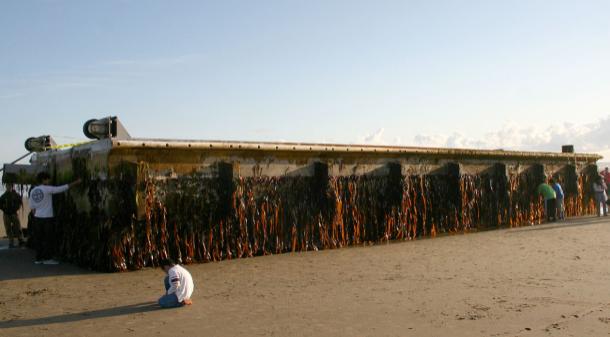 [5]By Oregon Department of Fish & Wildlife [6],
[5]By Oregon Department of Fish & Wildlife [6],
Debris from the March 2011 tsunami that struck Japan is starting to reach Oregon’s coast. Some of it may carry invasive species that could pose a serious threat to Oregon’s marine environment and native species. There are a number of things that Oregonians can do to help.
The Oregon Parks and Recreation Department responds to debris on beaches, and the Oregon Department of Fish and Wildlife leads the response to invasive species in coordination with the Oregon Invasive Species Council, Oregon State University and other partners. We recommend the following best practices to anyone who discovers marine debris – especially debris that has living organisms on it.
If you find marine debris that has living organisms attached: Take a photo, if possible, and send photo along with details (location, county, date found, description of item, what you did with the item) to [email protected]. This information will be shared with the marine debris response team and invasive species experts to determine what action needs to be taken.
If you are able to move the item, then please do your part. Help us clean up the debris and dispose of it as follows:
If you find small marine debrisitems—with or without living organisms – dispose of them in a garbage can off the beach or a landfill. If you are too far from a disposal site, remove the item from the water and place on dry land (above the high tide line) so that any organisms living on it will die and not be returned to the ocean. If you finddebris that is too large to remove: Report it and its location to Oregon Parks and Recreation Department via email, [email protected]
Never move debris with organisms on it to other bodies of water—an aquarium, pond or estuary. It increases the risk that invasive species will spread.
OPRD and ODFW staff also remind Oregonians that:
A lot of marine debris that washes ashore is not from the tsunami: Marine debris arrives on Oregon’s shore every day from around the Pacific. Accumulation and disposal of marine debris is an on-going management issue for OPRD
Not all marine debris carries invasive species nor does it pose a risk: Much of the marine debris that arrives onshore every day has living organisms on it; many of these organisms are native to the open ocean and do not pose a threat to our coastal environment. The items related to the Japan tsunami that are most likely to carry invasive species are those that were floating in Japan’s waters for extended periods of time before the tsunami—docks, buoys, barges and boats, for example.
Marine Invasive Species
Marine invasive species pose a serious threat to Oregon’s marine environment and native species by competing with our native fish and wildlife for food and habitat. While not all nonnative species are destructive, most often, they exist at the expense of native fish and wildlife and can impact the state’s economy.
For news on Japanese tsunami debris and marine invasive species and updates on best practices for handling debris, go to ODFW’s website: http://tinyurl.com/oregonmarineinvasives
Contact:
Meg Kenagy, Oregon Department of Fish and Wildlife, [email protected], (503) 947-6021
Chris Havel, Oregon Parks and Recreation Department, [email protected], (503) 986-0722